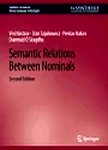版权所有:内蒙古大学图书馆 技术提供:维普资讯• 智图
内蒙古自治区呼和浩特市赛罕区大学西街235号 邮编: 010021

丛 书 名:Synthesis Lectures on Human Language Technologies
版本说明:2
I S B N:(纸本) 9783031010507
出 版 社:Springer Cham
出 版 年:1000年
页 数:XVI, 220页
主 题 词:Artificial Intelligence Natural Language Processing (NLP) Computational Linguistics
摘 要:Opportunity and Curiosity find similar rocks on Mars. One can generally understand this statement if one knows that Opportunity and Curiosity are instances of the class of Mars rovers, and recognizes that, as signalled by the word on, rocks are located on Mars. Two mental operations contribute to understanding: recognize how entities/concepts mentioned in a text interact and recall already known facts (which often themselves consist of relations between entities/concepts). Concept interactions one identifies in the text can be added to the repository of known facts, and aid the processing of future texts. The amassed knowledge can assist many advanced language-processing tasks, including summarization, question answering and machine translation. Semantic relations are the connections we perceive between things which interact. The book explores two, now intertwined, threads in semantic relations: how they are expressed in texts and what role they play in knowledge repositories. A historical perspective takes us back more than 2000 years to their beginnings, and then to developments much closer to our time: various attempts at producing lists of semantic relations, necessary and sufficient to express the interaction between entities/concepts. A look at relations outside context, then in general texts, and then in texts in specialized domains, has gradually brought new insights, and led to essential adjustments in how the relations are seen. At the same time, datasets which encompass these phenomena have become available. They started small, then grew somewhat, then became truly large. The large resources are inevitably noisy because they are constructed automatically. The available corpora—to be analyzed, or used to gather relational evidence—have also grown, and some systems now operate at the Web scale. The learning of semantic relations has proceeded in parallel, in adherence to supervised, unsupervised or distantly supervised paradigms. Detailed analyses of annota